Contents
Potatoes are considered an integral part of the diet for everyday consumption. The description of the Banba potato variety, photos and reviews indicate the promising possibilities of the culture. The variety is grown both for commercial purposes and for home use. It is advantageous to grow it on any type of soil, because the plant is resistant to many diseases.
Description of the Banba potato variety
Dutch and Irish scientists have obtained high-quality Banba potatoes by cross-breeding tests with nightshade varieties. During the experiments, the seeds of Estima and Sleni potatoes were used. The variety is young and appeared on the market several years ago. In a short period of time, he managed to gain popularity among gardeners and gardeners because of the taste, unpretentious cultivation techniques.
Domestic production of the variety is planned for 2018-2019, so planting material will be brought from Europe for several more years. Adult bushes reach a height of 50-60 cm. The foliage is dark green, the stem turns yellow closer to the base of the roots. A leaf of the usual form with a small corrugation, flowers of white color have a long flowering period. In terms of fruiting, it belongs to medium-early varieties.
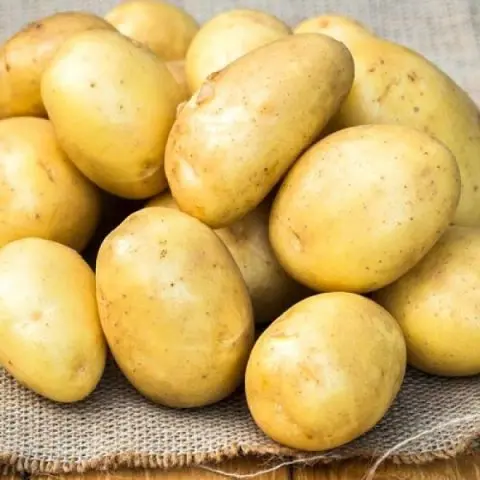
The variety brings a high-quality and tasty harvest. Tubers of leveled oval or round-flat shape. Banba potatoes are resistant to mechanical damage. Marketable yield is 90-95% of all potatoes. On tubers from 5 to 12 shallow eyes. There are elongated tubers. The peel is thin, dark yellow or light brown. The high starch pulp is pale yellow in color.
Banba Potato Taste
Tasters give 4,9 points for the taste of the Banba potato variety on a five-point scale, which emphasizes the quality of the tubers. The taste of potatoes without bitterness, although the dry matter is present in 20% content. The pulp is crispy, there are difficulties when cutting. The variety is great for frying, french fries, chips. After heat treatment, the tubers do not fall apart, sometimes the peel cracks, but the taste does not deteriorate.
The flowers and sprouts contain alkaloids, so they are used in traditional medicine only fresh. Mashed potatoes are used for diet, heart disease, disruption of the gastrointestinal tract. The raw variety of Banba is used for compresses for sore throats, pain in the legs, gastritis.
Pros and cons of the variety
Based on the reviews and characteristics of the Banba potato variety, gardeners note the following disadvantages:
- tubers growing in the sun quickly turn green, are not suitable for consumption;
- low resistance to late blight of tubers;
- does not tolerate frost well.
Banba Potato Benefits:
- drought tolerance;
- невосприимчивость к фитофторозу листвы, парше;
- good taste;
- universal use of tubers;
- long keeping quality;
- transportability over long distances;
- not damaged during harvesting;
- nutritious tubers, the presence of vitamins C, B6;
- commodity crop.
Planting and caring for Banba potatoes
Irish varieties adapt quite well to all types of soil and growing conditions. In any climatic zone of Our Country, the Banba potato quickly adapts and in any case will give a large harvest. However, in order to obtain a high-quality and large harvest, agrotechnical rules for planting potatoes should be observed.
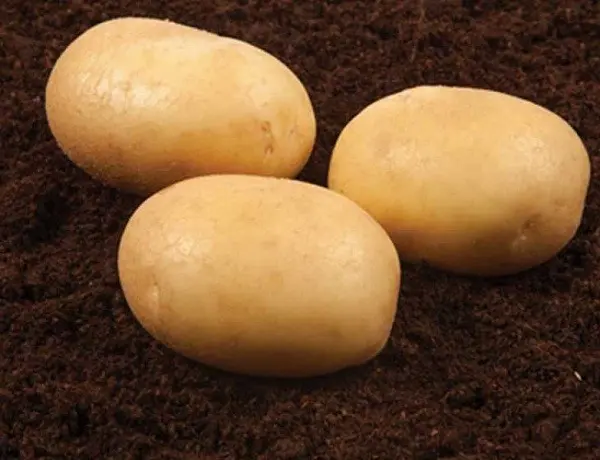
Selection and preparation of the landing site
In certain regions of the country, the quality of the soil leaves much to be desired, so acidic, saline or neutral soils must be fertilized frequently. Otherwise, the potatoes will not develop well. Banba grows well on loam and black soil. The seat should be well lit by the sun or partial shade will do. The landing site must be fenced off. Young bushes are very weak and may not resist the winds. So that the variety does not degenerate, every 3-4 years you need to change the planting site.
In autumn, the soil is dug up along with superphosphates, which will begin to act only in spring. Before planting, the soil is deeply dug up and disinfected: sprayed with a highly concentrated solution of potassium permanganate or chemicals. So that the solution does not burn the ground and spreads evenly, it is necessary to harrow the soil. Depending on the landing pattern, they make rows, pits, or plant them under a bayonet shovel. The distance between the rows is 30-40 cm, per 1 square. m planted 5-6 bushes of Banba potatoes.
Preparation of planting material
The preparation of the material begins with an inspection of the acquired tubers. Damaged, soft, shriveled or dried out potatoes are not suitable. For planting, the tubers of the Banba variety must be germinated. The rapid emergence of sprouts occurs with constant artificial light. In a greenhouse or an ordinary room, a pallet or box with potatoes is installed. The eyes should be directed upwards. Tubers are sprayed with growth stimulants for 2-3 days.
At low temperatures, potatoes are sprinkled with clay, sand, and the cracks are clogged with paper. Germination is done a week before planting. Planting material is ready for planting when the sprouts reach 3-5 cm. For planting, do not take large Banba potatoes, you can take medium or small tubers with a large number of eyes. Without equipment, you can put the potatoes on sheets of newspaper and cover with sawdust. In such conditions, spraying is carried out 1 time per day, because the sawdust will retain moisture for a long time.
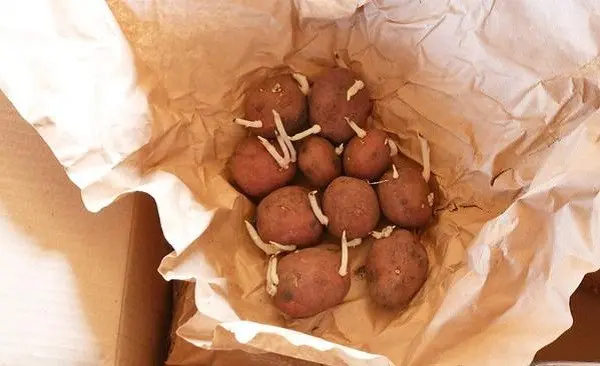
Rules of landing
Landing time is approximate. The end of May or the beginning of June is suitable, when the soil and air have a constant positive temperature of + 15-20 ° C. However, late planting reduces the yield. Complex fertilizer from wood ash, onion peel and a small amount of manure is added to dug holes or beds. In acidic soils, only dry slaked lime and compost are added.
The depth of the row, the pits are made small – 20-30 cm, because when deep digging, the soil should be loose on all sides for potatoes. This will not interfere with the development of sprouts. Sprouts up, potatoes are planted at a distance of 25-30 cm. Then they sprinkle with earth, harrow the soil to level the site.
Watering and top dressing
Watering begins after 3-4 days of planting. Sprouts have time to acclimatize, go to the initial growth. In the first month, water 2-3 times a week, monitor the condition of the soil. The soil should not be dry, cracked or waterlogged. After the appearance of young stems, Banba potatoes cannot be filled with water, so watering is reduced to 2 times a week. It is enough to water an adult plant once a week, although in dry weather the number of waterings is increased.
Top dressing is done at planting, then every 2-3 weeks. Potatoes are additionally fertilized with growth stimulants during the first few waterings. At the time of flowering, the Banba variety is fed with phosphates, a solution of saltpeter. Nitrogen supplements have a good effect on the growth of tubers, so a small amount of the substance is added to the soil a week after flowering. A month before harvest, a small amount of mullein or compost is added to the soil.
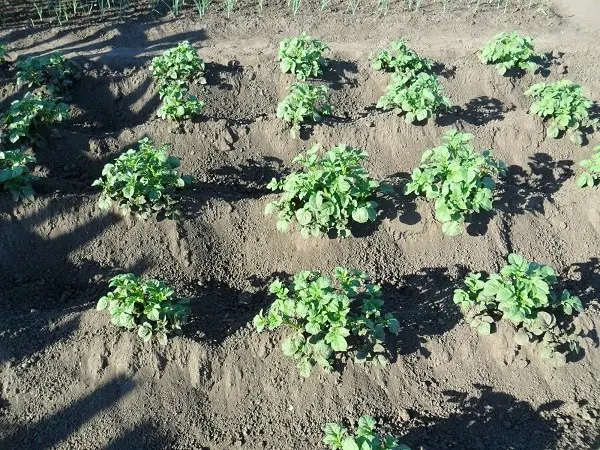
Loosening and weeding
The soil is loosened before each watering and with noticeable stagnation of the soil. Further, if necessary, raise the soil for improved oxygen supply to the root crops. Before hilling, it is necessary to carry out weeding and loosening. For weeding, use a garden rake or chopper that will not damage the young variety of Banba potatoes. After acid rain, it is necessary to water the potatoes and loosen the soil. Weeding is done every 2-3 weeks, during watering, residual weed roots are removed.
Hilling
Potatoes of the Banba variety are spudded when the stems of the plant reach 15-20 cm. Initially, hilling is done for each bush. 2 weeks before flowering, potatoes are spudded in a row. Mulching is done with hay, large or small sawdust. When mulching, watering is carried out once a week – the moisture lasts for a long time. Then, with each top dressing with dry fertilizer, the bushes are lightly spudded.
Diseases and pests
According to the provided photos of gardeners and the description of the variety, the Banba potato is attacked:
- colorado potato beetle;
- caterpillars;
- I’m going down.
As a preventive measure, the Banba variety is sprayed with Colorado, Tornado chemicals, and Colorado beetles are manually removed. From slugs use copper sulfate, sulfur or dust. Having immunity to common and powdery scab, potatoes are extremely resistant to tuber late blight. The appearance of a fungal disease is prevented by:
- processing potatoes before planting;
- early landing;
- turnover;
- landing without thickening;
- treatment of adult potatoes of the Banba variety with fungicides;
- deep weeding.
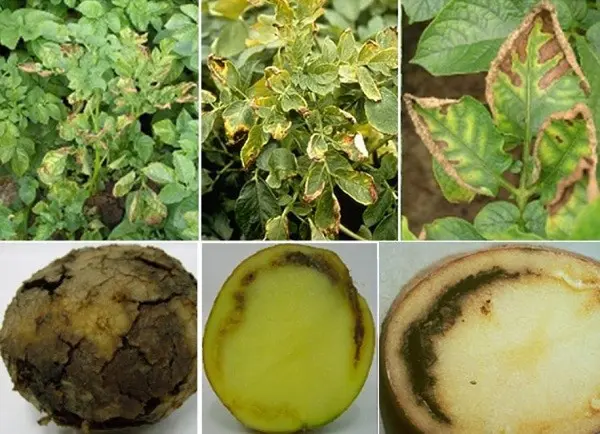
Potato yield
Up to 5-6 kg are harvested from the bush after proper care during cultivation. The average weight of commercial potatoes is approximately 100-150 g. The maximum yield per 10 acres is 180-210 kg. Root crops develop rapidly and are ready for harvest after 80-85 days, the first digging is done on the 60-70th day. Marketability of the crop – 96-98%, keeping quality – 95%.
Harvesting and storage
Potatoes are dug up in early or mid-August. It is not recommended to delay the harvest – the potato peel becomes thick, rough to the touch. Before laying for storage, the crop is allowed to rest, dry in the sun for 3-4 days. Tubers are sorted into usable, sale and waste. Banba potatoes are stored in a dry and dark place at a temperature of 0 to + 3-5 °C. The shelf life will increase if, after sorting, the tubers are treated with a weak solution of manganese, sprinkled with sand on the potatoes.
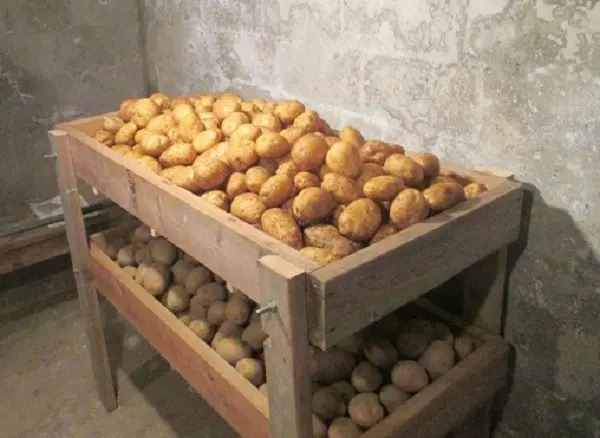
Conclusion
Description of the Banba potato variety, photos and reviews, as well as compliance with agrotechnical care rules will help you get a high-quality and tasty harvest. The Banba variety is reliable in cultivation. Many gardeners and gardeners recommend potatoes for sale.









